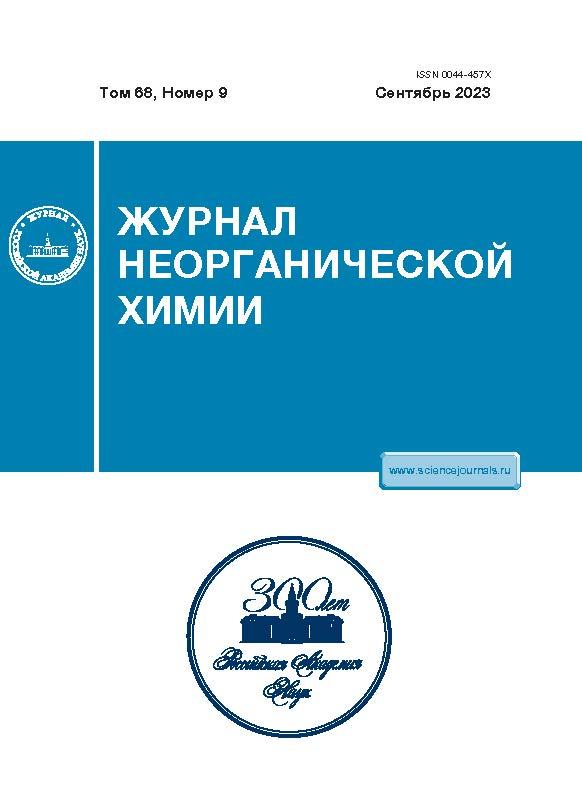Synthesis of Nickel(II) Complexes Based on Dialkylphosphorylpyridines and Their Cytotoxic Activity
- Authors: Enikeeva K.R.1, Kasimov A.I.1, Litvinov I.A.1, Lyubina A.P.1, Voloshina A.D.1, Musina E.I.1, Karasik A.A.1
-
Affiliations:
- Arbuzov Institute of Organic and Physical Chemistry, FRC Kazan Scientific Center, Russian Academy of Sciences
- Issue: Vol 68, No 9 (2023)
- Pages: 1137-1145
- Section: КООРДИНАЦИОННЫЕ СОЕДИНЕНИЯ
- URL: https://vietnamjournal.ru/0044-457X/article/view/666206
- DOI: https://doi.org/10.31857/S0044457X23600822
- EDN: https://elibrary.ru/YDQBSA
- ID: 666206
Cite item
Abstract
Bis-chelate nickel complex of composition [L2Ni(H2O)2](BF4)2 (4), where L = 1,3-dibenzhydryl-5-(pyridin-2-yl)-5-oxo-1,3,5-diazaphosphorinane, and tris-chelate complexes 5 and 6 of composition [L3Ni](BF4)2, where L = 2-diethylphosphorylpyridine and 2-diisopropylphosphorylpyridine, based on 1,4-N,O ligands L2–L4 with phosphoryl groups of acyclic and cyclic structure have been prepared. The structure and composition of complexes 4–6 were confirmed by mass-spectrometry, IR spectroscopy, thermogravimetric and elemental analysis. The structure of complexes 4-EtOH and 5 in crystals has been established by X-ray diffraction study. Cytotoxic properties toward M-HeLa and HuTu80 cancer cells and Chang Liver normal cell lines for the previously prepared nickel(II) complexes 1–3 based on 2-(oxophospholane)pyridines and the nickel(II) complexes obtained in this work have been studied. It has been found that the complexes with ligands containing cyclic phosphoryl groups show higher cytotoxicity toward cancer cells as compared with the complexes with their acyclic analogs.
About the authors
K. R. Enikeeva
Arbuzov Institute of Organic and Physical Chemistry, FRC Kazan Scientific Center, Russian Academy of Sciences
Email: kamtri95@mail.ru
420088, Kazan, Russia
A. I. Kasimov
Arbuzov Institute of Organic and Physical Chemistry, FRC Kazan Scientific Center, Russian Academy of Sciences
Email: kamtri95@mail.ru
420088, Kazan, Russia
I. A. Litvinov
Arbuzov Institute of Organic and Physical Chemistry, FRC Kazan Scientific Center, Russian Academy of Sciences
Email: kamtri95@mail.ru
420088, Kazan, Russia
A. P. Lyubina
Arbuzov Institute of Organic and Physical Chemistry, FRC Kazan Scientific Center, Russian Academy of Sciences
Email: kamtri95@mail.ru
420088, Kazan, Russia
A. D. Voloshina
Arbuzov Institute of Organic and Physical Chemistry, FRC Kazan Scientific Center, Russian Academy of Sciences
Email: kamtri95@mail.ru
420088, Kazan, Russia420088, Kazan, Russia
E. I. Musina
Arbuzov Institute of Organic and Physical Chemistry, FRC Kazan Scientific Center, Russian Academy of Sciences
Email: kamtri95@mail.ru
420088, Kazan, Russia
A. A. Karasik
Arbuzov Institute of Organic and Physical Chemistry, FRC Kazan Scientific Center, Russian Academy of Sciences
Author for correspondence.
Email: kamtri95@mail.ru
420088, Kazan, Russia
References
- Mobley H.L., Hausinger R.P. // Microbiol. Rev. 1989. V. 53. № 1. P. 85. https://doi.org/10.1128/mr.53.1.85-108.1989
- Huang W.-S., Liu S., Zou D. et al. // J. Med. Chem. 2016. V. 59. № 10. P. 4948. https://doi.org/10.1021/acs.jmedchem.6b00306
- Finkbeiner P.P., Hehn J., Gnamm C. // J. Med. Chem. 2020. V. 63. P. 7081. https://doi.org/10.1021/acs.jmedchem.0c00407
- Тригулова К.Р., Шамсиева А.В., Файзуллин Р.Р. и др. // Коорд. химия. 2020. Т. 46. № 9. С. 522. Trigulova K.R., Shamsieva A.V., Fayzullin R.R. et al. // Russ. J. Coord. Chem. 2020. V. 46. № 9. P. 600. https://doi.org/10.1134/S1070328420090055
- Chellan P., Nasser S., Vivas L. et al. // J. Organomet. Chem. 2010. V. 695. № 19–20. P. 2225. https://doi.org/10.1016/j.jorganchem.2010.06
- Lee S.-Y., Hille A., Frias C. et al. // J. Med. Chem. 2010. V. 53. № 16. P. 6064. https://doi.org/10.1021/jm100459k
- Pradeepa S.M., Bhojya Naik H.S., Vinay Kumar B. et al. // Spectrochim. Acta, Part A: Mol. Biomol. Spectrosc. 2013. V. 101. P. 132. https://doi.org/10.1016/j.saa.2012.09.062
- Sathisha M.P., Shetti U.N., Revankar V.K. et al. // Eur. J. Med. Chem. 2008. V. 43. № 11. P. 2338. https://doi.org/10.1016/j.ejmech.2007.10.003
- Datta S., Seth D.K., Gangopadhyay S. et al. // Inorg. Chim. Acta. 2012. V. 392. P. 118. https://doi.org/10.1016/j.ica.2012.05.034
- Savir S., Wei Z.J., Kent Liew J.W. et al. // J. Mol. Struct. 2020. P. 128090. https://doi.org/10.1016/j.molstruc.2020.12809
- Li P., Niu M., Hong M. et al. // J. Inorg. Biochem. 2014. V. 137. P. 101. https://doi.org/10.1016/j.jinorgbio.2014.04.0
- Sousa L.M., Souza W.A., Paixao D.A. et al. // Inorg. Chim. Acta. 2020. V. 511. P. 119824. https://doi.org/10.1016/j.ica.2020.119824
- Шамсиева А.В., Тригулова К.Р., Файзуллин Р.Р. и др. // Изв. АН. Сер. хим. 2018. Т. 67. № 7. С. 1206. Shamsieva A.V., Trigulova K.R., Fayzullin R.R. et al. // Russ. Chem. Bull. (Int. Ed.) 2018. V. 67. № 7. Р. 1206. https://doi.org/10.1007/s11172-018-2203-7
- Тригулова К.Р., Шамсиева А.В., Касимов А.И. и др. // Изв. АН. Сер. хим. 2022. № 7. С. 1410. Trigulova K.R., Shamsieva A. V., Kasimov A.I. et al. // Russ. Chem. Bull. 2022. V. 71. № 7. P. 1410. https://doi.org/10.1007/s11172-022-3547-6
- Enikeeva K.R., Shamsieva A.V., Kasimov A.I. et al. // Inorg. Chim. Acta. 2023. V. 545. P. 121286. https://doi.org/10.1016/j.ica.2022.121286
- APEX2 (Version 2.1), SAINTPlus. Data Reduction and Correction Program Version 7.31A, Bruker Advansed X-ray Solutions, Bruker AXS Inc., Madison, Wisconsin, USA, 2006.
- Sheldrik G.M. SADABS, Program for empirical X-ray absorption correction, Bruker-Nonis, 1990–2004.
- Sheldrick G.M. // Acta Crystallogr., Sect. A. 2015. V. 71. P. 3.
- Sheldrick G.M. // Acta Crystallogr., Sect. C. 2015. V. 71. P. 3.
- Spek A.L. // Acta Crystallogr., Sect. D. 2009. V. 65. P. 148.
- Farrugia L.J., Win J. // J. Appl. Crystallogr. 2012. V. 45. P. 849.
- Macrae C.F., Sovago I. et al. // J. Appl. Crystallogr. 2020. V. 53. P. 226. https://doi.org/10.1107/S1600576719014092
- Zhang S., Pattacini R., Jiea S. et al. // Dalton Trans. 2012. V. 41. P. 379. https://doi.org/10.1039/c1dt11352f
- Li Z., Sun W.-H., Wang L. et al. // J. Chem. Crystallogr. 2002. V. 32. P. 107. https://doi.org/10.1023/A:1015673100877
- Dodoff N., Maccek J., Angelova O. et al. // J. Coord. Chem. 2015. V. 22. P. 219. https://doi.org/10.1080/00958979009408218
- Montagner D., Fresch B., Browne K. et al. // Chem. Commun. 2017. V. 53. № 1. P. 134. https://doi.org/10.1039/C6CC08100B
Supplementary files
















